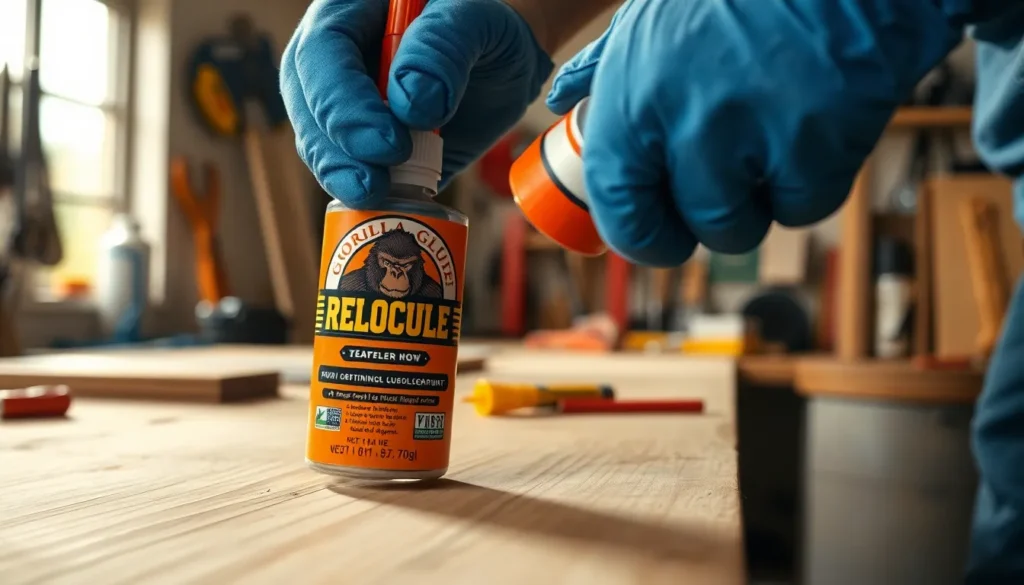Table of Contents
ToggleWhen it comes to tackling DIY projects, Gorilla Glue is the superhero in a bottle. With its legendary strength and versatility, it’s no wonder people are turning to this sticky sidekick for everything from crafting to home repairs. But just how long does it take for this mighty adhesive to dry?
Understanding Gorilla Glue
Gorilla Glue stands out as a powerful adhesive, especially in DIY projects, crafting, and home repairs. Its unique properties contribute to its effectiveness.
Composition and Properties
Gorilla Glue consists primarily of polyurethane. This composition enables strong bonding across different surfaces, including wood, metal, and ceramics. Moisture activates the glue, expanding as it cures, which fills gaps and creates a secure hold. Flexibility characterizes the final bond, making it resistant to impact and temperature changes. An important aspect is its ability to adhere to unprepared surfaces, allowing for a wide range of applications.
Types of Gorilla Glue
Gorilla Glue offers several varieties suited for different tasks. The original Gorilla Glue features a polyurethane base, ideal for heavy-duty projects. Gorilla Super Glue provides a convenient, fast-drying solution for smaller repairs. Gorilla Wood Glue is specifically formulated for woodworking, promoting superior bonding between wooden materials. In addition, Gorilla Clear Grip serves as a transparent adhesive, suitable for both indoor and outdoor tasks. Each type has distinct properties to meet various user needs effectively.
Drying Time Factors

Gorilla Glue’s drying time varies based on several influential factors. Understanding these aspects can help ensure optimal results for any project.
Environmental Conditions
Temperature and humidity significantly impact the drying time of Gorilla Glue. High humidity can accelerate the curing process due to moisture activation. Conversely, low temperatures may prolong drying time, potentially resulting in weaker bonds. Maintaining an ideal temperature around 70°F to 90°F promotes quicker curing. Additionally, working in well-ventilated areas can enhance the drying efficiency, reducing the overall wait time.
Material Compatibility
Different materials can affect Gorilla Glue’s bonding timeframe. Porous surfaces, such as wood, absorb moisture from the glue, resulting in faster curing. Non-porous surfaces, like metal or glass, may require longer drying periods. Surface preparation also matters; clean and dry surfaces facilitate a stronger bond, optimizing drying time. Understanding the compatibility of materials helps users anticipate how long to wait before handling the glued item.
Estimating Drying Time
Understanding Gorilla Glue’s drying process is essential for achieving the best results. Different factors influence both initial set time and full cure time, affecting how soon projects can be used.
Initial Set Time
Initial set time refers to the period during which the bond begins to hold and forms a temporary adhesive connection. Gorilla Glue typically sets in about 20 to 30 minutes. Factors such as temperature and humidity can alter this timeframe; higher temperatures expedite the setting process while higher humidity can also shorten it. Users should ensure that the surfaces are clamped firmly during this period to maintain alignment. Bonding occurs faster with porous materials like wood, as they absorb moisture and help activate the glue.
Full Cure Time
Full cure time denotes when the bond reaches its maximum strength. For Gorilla Glue, this usually takes 24 hours. Environmental conditions play a significant role here as well; drying in lower humidity levels may prolong this duration. Curing occurs more quickly in warm conditions, ideally between 70°F and 90°F. Users should avoid disturbing the bond before this period ends to ensure maximum strength and durability. Properly prepared surfaces maximize adhesion, contributing to a more effective curing process.
Tips for Optimal Results
Achieving optimal results with Gorilla Glue requires attention to detail in preparation and application techniques. Following these tips ensures a strong, lasting bond.
Surface Preparation
Surface preparation plays a crucial role in bond strength. Clean surfaces remove dust, oil, or moisture that can weaken the adhesive. Sanding wooden pieces improves bonding by increasing surface area. For non-porous materials, wiping with a solvent guarantees a better grip. Ensure all surfaces align properly, as any gaps may result in a compromised bond. Allow any cleaned surfaces to dry completely before applying the glue. Taking these steps enhances the adhesive’s ability to cure effectively.
Application Techniques
Application techniques greatly affect the drying process. Apply a thin, even layer of Gorilla Glue to one surface for the best results. Avoid over-applying, as excess glue can expand and create messes during curing. Press surfaces together firmly and ensure they are aligned, promoting an even bond. Use clamps to hold pieces together for at least 20 to 30 minutes, preventing movement during the initial set time. Check the manufacturer’s instructions for recommended curing conditions, such as temperature and humidity, as these factors influence the overall strength of the bond.
Gorilla Glue’s effectiveness hinges on understanding its drying and curing times. By taking into account environmental factors and surface preparation users can ensure a strong bond that lasts. The initial set time allows for alignment while the full cure period solidifies the bond’s strength.
For the best results it’s crucial to follow application guidelines and remain patient during the curing process. With the right approach Gorilla Glue can serve as a reliable solution for various projects, providing durability and versatility in every application.




